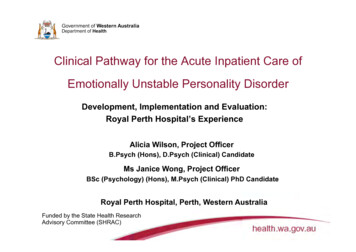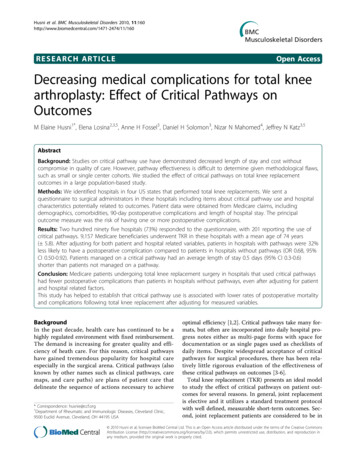
Transcription
Clinical Pathway for the Acute Inpatient Care ofEmotionally Unstable Personality DisorderDevelopment, Implementation and Evaluation:Royal Perth Hospital’s ExperienceAlicia Wilson, Project OfficerB.Psych (Hons), D.Psych (Clinical) CandidateMs Janice Wong, Project OfficerBSc (Psychology) (Hons), M.Psych (Clinical) PhD CandidateRoyal Perth Hospital, Perth, Western AustraliaFunded by the State Health ResearchAdvisory Committee (SHRAC)
Background§ Clinical practice guidelines for EUPD published byThe National Institute for Clinical Excellence(2009) , and National Health and MedicalResearch Council (2012)§ Guidelines emphasised:§ The importance of avoiding inpatient mental healthadmissions§ When an admission is clinically indicated due toacute risk to self or others, length of admissionsshould be brief
BackgroundHowever:§ Patients with EUPD have been found to be one of the highest usersof inpatient and emergency department services (Ansell, Sanislow,McGlashan, & Grilo, 2007; Bender et al., 2006; Hörz, Zanarini, Frankenburg, Reich, & Fitzmaurice,2010; Zanarini, Frankenburg, Hennen, & Silk, 2004).§ An estimated 72% of patients with EUPD will require hospitalisationin the course of their treatment (Lieb, Zanarini, Schmahl, Linehan, & Bohus, 2004)§ Represent between 25% and 30% of all psychiatric admissions(Zimmerman, Chelminski, & Young, 2008).§ Length of hospitalisation rarely brief (Dasgupta & Barber, 2004; Nelson, 2013).§ Repeated presentations (Dasgupta & Barber, 2004; Nelson, 2013).
Rationale§ Inpatient services will have ongoing role in care of EUPDpatients§ Furthermore, there has been no published researchevaluating the feasibility or effectiveness of translating theseguideline recommendations in the inpatient settingTherefore, RPH embarked on an initiative to bridge the gapbetween evidence and practice by designing a ClinicalPathway for the acute inpatient care of patients with EUPD
Outline§ § § § ContextDeveloping the Clinical PathwayImplementation & EducationClinical Pathway§ § § § § § DiagnosisSafety PlanningSkills GroupCrisis Management PlanningPatient Controlled Crisis AdmissionsEvaluation
Context – Royal Perth Hospital (RPH)§ Large tertiary hospital in Perth, Western Australia§ Mental Health Unit:§ 20 bed, non-authorised psychiatric facility§ Staffed by a multidisciplinary team§ In Central Business District§ Provides services across WA, regardless of residentialarea (i.e., no catchment)§ Patient mix: mood disorders, personality disorders, acutereactions, schizophrenia, substance use disorders§ Personality disorders – 30-40% of patient mix per year,and high usage of ED services
Development of the Clinical Pathway§ Developed in four stages between June 2011 – June2013§ Developed in consultation with representatives from eachdiscipline§ § § § Stage One: Gathered evidenceStage Two: Review of existing servicesStage Three: Iterative drafting and review of PathwayStage Four: Implementation
Two Staged Clinical Pathway:Two-staged approach designed to balance therecommendation of brief admissions with the need tovalidate patient’s experience and deliver high quality carethat covers all the recommendations:1. First or Review Admission7-12 daysClinicianEducation &Support2. Patient Controlled Crisis Admissions1-3 days
Pathway: Stage One –Collaboratively Determined Diagnosis§ Communication of diagnosis to patient essential§ To offer patient explanation for their experience, empower themto engage with own treatment and promote optimism and hopein recovery based on a link to proven treatments§ Medical Team & Clinical Psychology Training§ Education workshops, role play of providing diagnosis intherapeutic manner, in context of formulation§ 2 page example script in Clinician Handbook
Pathway: Stage One – Safety Planning§ Proactive strategy to ensure safety on ward§ Collaboratively developed with patient§ Step-by-step plan using prompting questions, patient’sanswers recorded in their own words§ Identifies:§ § § § § TriggersWarning signsCurrent coping strategiesHelpful coping strategiesA plan for when things escalate§ Patient and staff sign the plan to acknowledgeunderstanding and commitment to using the planduring their inpatient stay
Pathway: Stage One – DBT Skills Group§ Three groups per week, 1.5hrs per Group§ Mindfulness§ Distress Tolerance/Affect Regulation§ Effective Communication§ All diagnoses§ Nurse Therapist & Clinical Psychology facilitated§ Mixed Inpatients and Outpatients§ Outpatient can attend up to 6 weeks post discharge astransition support§ Open / rolling flexible content
Pathway: Stage One – Future hospital accessLimitations with the traditional gatekeeper model:§ Establishes a power relation between the clinician and patient (Hoch,O’Reilly, & Carscadden, 2006; Krawitz & Watson, 2000).§ Patient feels compelled to accentuate visible distress to ensure theclinician gains an understanding and grants request for admission(McMahon & Lawn, 2011; Nehls, 2000; Strand & von Hausswolff-Juhlin, 2015).§ When admission is ‘granted’ in this way, it likely reinforces thisaccentuating behaviour and undermines the process of collaborationand personal accountability (Eastwick, 2005; Nehls, 1994, 2000).§ Increases the time needed to stabilise symptoms and recover from acrisis, extending the length of time in hospital.§ When denied admission, the patient’s core beliefs activated and theircommunication of significant distress invalidated.§ This potentially perpetuates the invalidating environments in whichtheir disorder was likely borne (Linehan, 1987; Linehan, 1993; Nehls, 1994, 2000).
Pathway: Stage One – Future hospital access§ Consequently, patients may exhibit intense emotionalresponses (serious self-harm, aggression or hostility)§ Has the potential to perpetuate unhelpful relationshipswith clinicians and the service and contribute to repeatedpresentations until an admission is granted (McMahon & Lawn, 2011).§ This highlighted the need to consider alternatives to thetraditional gatekeeper model.
Pathway: Stage One – Patient ControlledAdmission PlanPatient works with team to develop an extension of their safety plan,that documents steps they are to take to reduce distress and risk ofsuicide or self harm following discharge, including the option ofpresenting to ED when other resources are insufficient in reducingrisk; guaranteed a bed pending availability for:Patient Controlled 3 Day Crisis Admission.§ Transfers responsibility of assessing emotional state from health careservices to the individual themselves – fostering self-responsibility§ Ensures patients do not have to escalate, self harm or attempt suicideto ensure admission, shifts the power differential and breaks cycle ofmaladaptive help seeking§ Ensures patients are less resistant to discharge through ease ofadmission
Pathway: Stage Two – Crisis Admissions By eliminating the need to engage in unhelpful behaviours to gainadmission and having the understanding of hospital staff, morequickly ‘contain’ the patient and allow him/her to focus on thestrategies identified that will help de-escalate the distress 1 x session with clinical psychologist to conduct ‘chain analysis’of crisis 1:1 with nurses Attend group therapy 6 more weeks of outpatient groups if deemed necessary Re connect with community providers
Evaluation - Methods§ Design:§ Single-centre combined clinical audit and historicalcontrol group design§ Historical control cohort:§ Collected during Stage One of Development§ 130 patients§ Clinical Pathway cohort:§ 179 patients
Evaluation - Methods§ Outcomes:§ Length of stay§ Hours of Psychological Therapy attended§ Psychiatric symptomatology (admission todischarge)§ Patient satisfaction§ Likelihood and number of readmissions§ Likelihood and number of presentations to ED§ Total Bed days
ParticipantsNumberAge (years)Gender (% female)Living Location (% Ruraland Remote)Ethnicity (% Aboriginal)Self-Harm atPresentation of IndexAdmission (%)Historical cohortClinical Pathwaycohort13035.5 12.259.1%17933.7 11.167%5.80%5.00%13.90%14.50%16%22%
Statistical Analysis§ Treatment effects regression§ Multilevel mixed-effects linear regression§ To determine the group differences inchanges in psychiatric symptomatologyfrom admission to discharge§ All analyses conducted using STATA 14
Outcome VariableAttended Psychological TherapyPsychological Therapy HoursattendedLength of Index Admission (days)ReadmissionNumber of ReadmissionsRe-Presentation to EDNumber of Re-Presentations to EDTotal Bed Days of ReadmissionsAverage TreatmentEffect95%Confidence Interval14.83%*3.39%24.40%2.78*1.024.59 5.16** 1.91 8.05 6.03% 18.62%2.52% 0.75* 0.19 3.812.91% 4.75%16.45% 0.10 0.480.28 8.22* 2.10 17.51*p 0.05; **p 0.001.Each outcome and treatment model contains the following covariates; Age, Gender, Ethnicity, Living Location,EUPD Primary Diagnosis, Reaction to severe stress, and adjustment disorders, Depressive Disorders,Mental and behavioural disorders due to psychoactive substance use, Physical Health Disorders, OtherPersonality Disorder, Neurotic (Anxiety) Disorders, Bipolar Affective Disorders, Schizophrenia, schizotypaland delusional disorders
Sub-analysis: Patient Symptoms§ Patient symptomology was assessed onadmission and prior to discharge using theBASIS-24.§ BASIS-24 Total scores:§ Both Historical and Pathway cohort hadstatistically significant reductions over time§ Symptomatology of Pathway cohort werenot significantly different to Historical cohorton discharge
Sub-analysis: Patient Satisfaction§ Overall satisfaction was not significantlydifferent between the two cohorts.§ Patients in Pathway cohort reported beingmore satisfied with their involvement intheir treatment planning than patients inHistorical cohort (p .005)
Cost EffectivenessAverage TreatmentEffect195% Bias CorrectedConfidence IntervalsLength of Index Admission(Days)5.161.918.05Mental Health Bed days fromReadmissions (Days)8.222.117.5113.384.0125.56Total Sample Bed Day Savings(Days)2395.02717.794575.24Total Sample Savings (Savings) 3,592,530.00Total Per Patient Bed DaysSavings (Days)Program InvestmentTotal Return on Investment 1,076,685.00 6,862,860.00 150,000 3,442,530.001. Calculated based on n 179 in treatment sample and the averagecost of a bed day on the RPH MHU 1500 926,685.00 6,712,860.00
DiscussionThe implementation of the Pathway:§ Improved outcomes for individuals with EUPDin a number of areas§ § § § Hours of psychological therapyLength of index and readmissionsSymptomatologySatisfaction
Implications§ Clinical implications§ Pathway provided a consistent model, in line withevidence-base for the provision of care for individualswith EUPD during their inpatient stay§ Increased consumers’ ability to manage within thecommunity for longer periods of time§ Service provision:§ Pathway allowed the MHU to take on a greatercaseload within the 12 month period, thereforeallowing more individuals access mental health care
Emotionally Unstable Personality Disorder§ EUPD ICD-10 equivalent to Borderline Personality Disorder (BPD)§ Affects over 500,000 Australians, with a lifetime prevalence of 2.28%(Jackson & Burgess, 2000).§ Common experiences include:§ Extreme and poorly controlled emotional states§ Impulsivity§ Tumultuous relationships§ Self destructive behaviours (American Psychiatric Association, 2000).§ Significant functional impairments and distress due these symptoms, whichare often present across their social, family and work lives (Leichsenring,Leibing, Kruse, New, & Leweke, 2011b; Skodol et al., 2005).§ As a result, individuals with EUPD often present to hospital emergencydepartments seeking support through an acute inpatient mental healthadmission
Step-by-step plan using prompting questions, patient's answers recorded in their own words ! Identifies: ! Triggers . (McMahon & Lawn, 2011; Nehls, 2000; Strand & von Hausswolff-Juhlin, 2015). . with clinicians and the service and contribute to repeated presentations until an admission is granted (McMahon & Lawn, 2011). .











